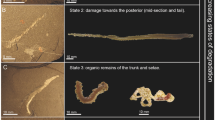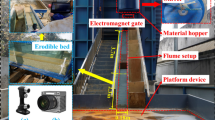Abstract
FLUTE marks abound as moulds in rocks attributed to turbidity current action1 and are not uncommon in beds assigned a fluviatile origin2. It was early recognized that flute marks are caused by the eroding action of currents of water on cohesive mud beds. Much later it was found experimentally1 that the growth of flutes depended in some way on eddying motions in the current of fluid acting on the bed, although no clear idea emerged at the time as to the physical character of these eddies nor as to how they were involved in the bed erosion.
This is a preview of subscription content, access via your institution
Access options
Subscribe to this journal
Receive 51 print issues and online access
$199.00 per year
only $3.90 per issue
Buy this article
- Purchase on Springer Link
- Instant access to full article PDF
Prices may be subject to local taxes which are calculated during checkout
Similar content being viewed by others
References
Dzulynski, S., and Walton, E. K., Sedimentary Features of Flysch and Greywackes (Elsevier, Amsterdam, 1965).
Cummins, W. A., Liverpool Manchester Geol. J., 2, 37 (1958).
Allen, J. R. L., J. Sediment. Petrol., 35, 331 (1965).
Allen, J. R. L., Geol. en Mijnb., 47, 3 (1968).
Middleton, G. V., Canad. J. Earth Sci., 4, 475 (1967).
Schlichting, H., Boundary Layer Theory, fourth ed. (McGraw-Hill, New York, 1960).
Freymuth, P., J. Fluid Mech., 25, 683 (1966).
Raudkivi, A. J., J. Fluid Mech., 26, 507 (1966).
Moore, W. L., and Masch, F. D., J. Geophys. Res., 67, 1437 (1962).
Spalding, D. B., J. Fluid Mech., 27, 97 (1967).
Allen, J. R. L., J. Fluid Mech., 25, 331 (1966).
Allen, J. R. L., Current Ripples (North Holland, Amsterdam, 1968).
Author information
Authors and Affiliations
Rights and permissions
About this article
Cite this article
ALLEN, J. Flute Marks and Flute Separation. Nature 219, 602–604 (1968). https://doi.org/10.1038/219602a0
Received:
Issue Date:
DOI: https://doi.org/10.1038/219602a0
This article is cited by
-
On local Görtler instability
Zeitschrift für angewandte Mathematik und Physik ZAMP (1971)
Comments
By submitting a comment you agree to abide by our Terms and Community Guidelines. If you find something abusive or that does not comply with our terms or guidelines please flag it as inappropriate.



